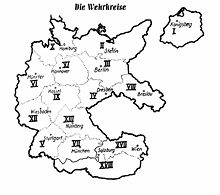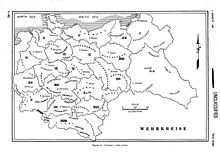- Military district (Germany)
-
 The Wehrkreise after the Anschluss
The Wehrkreise after the Anschluss
During World War II Germany used the system of military districts (German: Wehrkreis) to relieve field commanders of as much administrative work as possible and to provide a regular flow of trained recruits and supplies to the Field Army. The method they adopted was to separate the Field Army (Oberbefehlshaber des Heeres) from the Home Command (Heimatkriegsgebiet) and to entrust the responsibilities of training, conscription, supply and equipment to that command.[1]
The Commander of the Infantry Corps with the identical number also commanded the Wehrkreis in peacetime, but command of the Wehrkreis passed to his second-in command at the outbreak of war.
Before the start of the war, there were also four Motorized Army Corps (in effect, staffs to control the training of Panzer and Light Panzer formations) which had no corresponding military districts, but were served (as regards conscription and supplies) by the districts in which Corps headquarters or subordinate formations had their Home Garrison Stations. These Corps were:
- XIV Army Corps (Motorized) - XIV. Armeekorps (mot.)
- XV Army Corps (Motorized) - XV. Armeekorps (mot.)
- XVI Army Corps (Motorized) - XVI. Armeekorps (mot.)
- XIX Army Corps - XIX. Armeekorps
The Districts were organized into a Chain of Command that included Area Headquarters (Wehrersatzbezirk Hauptquartier) and Sub-area headquarters (Wehrbezirk Hauptquartier).
During World War II, Germany was divided into nineteen military districts. At the start of the war, there were only fifteen:
- I - Königsberg
- (East Prussia; Memel; and Bialystok))
- Königsberg
- Tilsit; Gumbinnen; Treuburg; Bartenstein; Braunsberg; Allenstein; Sudauen;
- Allenstein
- Lötzen; Zichenau
- Königsberg
- (East Prussia; Memel; and Bialystok))
- II - Stettin
- (Mecklenburg and Pomerania)
- Köslin
- Stolp; Kolberg; Neustettin; Deutsch Krone; Woldenburg/Neumark
- Stettin;
- Swinemünde; Preußisch Stargard; Greifswald; Stralsund
- Köslin
- (Mecklenburg and Pomerania)
- III - Berlin
- (Brandenburg and part of Neumark)
- IV - Dresden
- V - Stuttgart
- (Württemberg; part of Baden; and Alsace)
- VI - Münster
- (Westphalia; Rhineland; and the Eupen-Malmedy district of Belgium)
- VII - Munich
- (Southern Bavaria)
- VIII - Breslau
- Silesia; the Sudetenland districts of Bohemia and Moravia; and southwest Poland
- IX - Kassel, included parts of Thuringia and Hesse. The Commander was General der Infanterie Schellert over three Bereich Hauptsitze:
- Kassel (nine Unterregion-Hauptsitze): Kassel I, Kassel II, Korbach, Marburg (Lahn), Hersfeld, Siegen, Wetzlar, Fulda, & Giessen.
- Frankfurt am Main (six): Frankfurt am Main I, Frankfurt am Main II, Offenbach am Main, Aschaffenburg, Friedberg, &Hanau.
- Weimar (nine): Weimar, Sangerhausen, Gera, Rudolstadt, Mulhausen (Thuringia), Erfurt, Eisenach, Gotha, & Meiningen.
- X - Hamburg
- (Schleswig-Holstein; part of Hanover; and Danish Slesvig
- XI - Hanover
- (Braunschweig; Anhalt, and Magdeburg)
- XII - Wiesbaden
- (Eifel; Koblenz; Mannheim; Metz; the Palatinate; the Saar; Lorraine; Nancy; and Luxembourg)
- XIII - Nürnberg
- (Northern Bavaria; western Bohemia; Regensburg; and Eger)
- XVII - Vienna
- XVIII - Salzburg
Wehrkreis XX and XXI were established in Poland to control Danzig and Posen, which were a part of the German Empire before the First World War and were annexed into Germany after 1939.
- XX - Danzig
- (Danzig Free State; Polish Corridor; Neustadt an der Dosse; Stargard in Pommern; Marienwerder; Graudenz; Bromberg and Thorn)
- XXI - Posen
- (Posen; Lissa; Hohensalza; Leslau; Kalisch; and Litzmannstadt)
Two additional Wehrkreis were established after the invasion of Poland. These were Wehrkreis Böhmen-Mähren which covered the so-called Protectorate of Bohemia-Moravia that was Czech areas not part of the Sudetenland and Wehrkreis General-Government which controlled the remainder of Poland.
It has been speculated that the missing Wehrkreis number—XIX—was intended for use inside Russia if Germany had been successful in completing the invasion and additional numbers would have been assigned to the named Wehrkreis at the end of the war.
In peace time, the Wehrkreis was the home to the Infantry Corps of the same number and all subordinate units of that Corps.
References
- ^ B2 Ian V. Hogg ed., German Order of Battle 1944
Sources
- Hogg, Ian V., German Order of Battle 1944: The regiments, formations and units of the German ground forces, Arms and Armour Press, London, 1975
Categories:- Military units and formations of Germany
Wikimedia Foundation. 2010.

